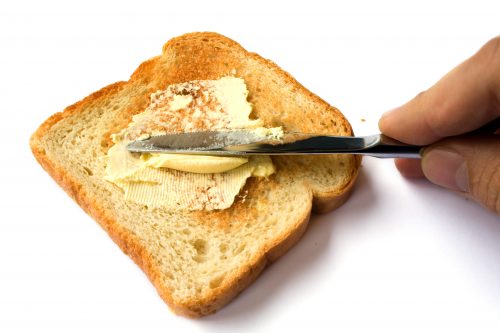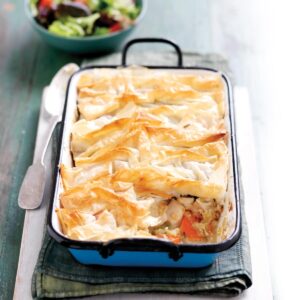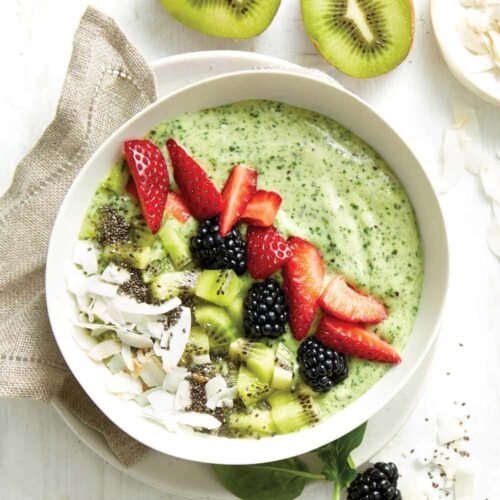
A guide through the wide variety of spreads on the market.
A brief history of spreads
When I was a girl, butter was what you put on your toast, no debate. To be honest, there wasn't actually an alternative. Then margarine came along and took the world by storm with its claim of healthier fats. You see, butter is over 50% saturated fats, the ones that will clog your arteries and lead you to sudden death. Margarines on the other hand were made with polyunsaturated fats, the good guys.
Unfortunately what wasn't realised in the early days was the margarines also contained trans fats, which were just as bad as, if not worse than, saturated fats. Although the margarines did have less than 30% trans plus saturated fats, this small trans fat problem did tend to undermine the 'good fat' story.
Making spreads has changed a lot since then, and these days many spreads contain less than 1% trans fats. You needn't accept anything more. But don't assume: watch out for ones like Meadowlea Original which still contains 8% trans fats.
Butter butters better?
Not any more, it doesn't. The food regulations state that to be called butter or margarine the product must be at least 80% fat. These days we know better than to use spreads so high in fat, so if it's labelled as 'butter' or 'margarine', walk on by; you really don't need it.
If you love the butter flavour (and promise not to kill yourself using lashings of it) you could try a butter blend like Anchor spreadable, a mix of butter and oils (70% fat, 32% saturated) or preferably a lower-fat version like Mainland Country Soft lite (60% fat, 24% saturated). Having said that, a solely oil-based spread is highly recommended as these will be a lot lower in saturated fats, and many are much lower in total fat as well.
Oil-based spreads
Monounsaturated fats have been shown to be good for heart health. Spreads made with olive oil, canola oil, avocado oil or rice bran oil will tend to be higher in monounsaturated fats than those made with sunflower or other, often unspecified, vegetable oils. But the best way to know what you're getting is to look at the nutrition information. I prefer spreads where over 1/3 of the fat is monounsaturated.
- A spread described as 'olive oil spread' is made using a blend of vegetable oils, including olive oil. For example, Olivani standard contains 22% olive oil; in Olivio it's 21% or for Olivio lite, 16%.
- Olivani avocado spread uses a blend of oils containing 14% olive oil and 7.5% avocado oil.
- Alfa One rice bran oil spread contains just one oil: rice bran oil.
Baking and cooking with reduced-fat spreads
As a rule of thumb for baking recipes, when you're replacing butter or margarine use a spread with a minimum of 60% fat, as the lower fat spreads contain more water. Spreads with 50-60% fat can be used for most cooking and sautéing (although an oil/spray would be better).
Plant sterols
Plant sterols are naturally found in small amounts in many fruits, vegetables, nuts, seeds, cereals and legumes. There is evidence that spreads enriched with plant sterols, like Flora pro-activ and Meadowlea Logicol, can help reduce cholesterol levels (total and LDL cholesterol) by reducing the absorption of cholesterol. Because plant sterols have a similar chemical structure to cholesterol (a sterol found mainly in animal tissue), they compete for absorption.
You need to consume 25g of the enriched spread each day for it to be effective and there's no extra benefit from having more. 25g (that's about 5 teaspoons) has around 625kJ in the standard spreads but only about 375kJ in a light version. Many (but not all) people with high cholesterol also need to lose weight, so I'd always recommend going for a light version. If you already take cholesterol-lowering medication, it's best to talk to your GP about whether these products are suitable for you.
Rice bran oil spreads also contain plant sterols, from the rice bran. Although these may also help lower cholesterol, there is no indication how much would be required to do that. Alfa One Rice Bran oil spreads contain 1.5g plant sterols per 100g compared to Flora pro activ and Logicol, which contain 8g per 100g.
What's new in spreads?
- Flora, in both standard and the pro-activ ranges, have introduced 'ultra-light' varieties. At 23% fat these are very low-fat spreads. Definitely worth a try (but don't try baking with them).
- Alfa One Rice Bran Oil spread is now available in a 'lite' version. The standard product is 81% fat, so we're pleased to see this one at just 52%.
- Mainland want to extend your use of butter with their new range of butter infusions – butter sticks infused with herbs and spices – but don't forget, it's still butter.
Alternatives to spreads
Bored with spreads, or not that keen on the flavour? One option is to ditch the spread entirely. People think I'm odd, but I never use spreads in sandwiches and I put honey or peanut butter straight onto toast without any spread. I've been doing it for so long the thought now of putting a fatty spread on first is quite unappealing (I prefer my fat in chocolate!). If you're not quite ready to ditch the spreads altogether you could try using one of these:
- Avocado – still 25% fat, but high in the good monounsaturated fats. If you used 1/8 of an avocado instead of a tablespoon of low-fat spread, you'd be adding only 200kJ to your sandwich rather than 300kJ – along with a little fibre and other nutrients.
- Extra-lite cream cheese – even lower in kilojoules than the avocado and adds some calcium.
- Hummus – dollop two tablespoons of hummus onto a slice of toast and you'll have similar kilojoules to a tablespoon of low-fat spread, but you'll be adding some legumes to your day (ground chickpeas) and you won't need anything else on top as it has loads of flavour.
What does it mean?
- No cholesterol: Cholesterol is only found in animal products, so they're just telling you it's an oil-based spread. Butter contains a small amount of cholesterol.
- 100% pure: There's no prescribed meaning for this phrase so it means whatever the manufacturer wants it to. If you're attracted by phrases like this, take a moment to read the label – find out if it's telling you what you expected about the product.
- 30% less fat: Make sure you don't think that's '30% fat' – it's easy to do when you glance at it in the shop. You need to check the total fat to know what you're getting. Reduced-fat spreads generally compare themselves to a standard 80% fat margarine.
- Light or lite: This descriptor highlights that the spread has less fat than its 'original' counterpart, but the amount of fat in these products varies from around 60% or less.
-
Reduced salt: This is also compared to the standard product of that brand, so check the nutrition information. You may also notice that reduced fat versions tend to be lower in sodium anyway.
Meadowlea reduced salt contains 360mg sodium per 100g spread compared to Meadowlea Original at 660mg/100g. But the Meadowlea Lite and Meadowlea Canola both only contain 390mg/100g. - Source of omega-3: That's nice, but don't think it's the same as fish oils, which are providing essential long-chain omega-3s and in greater amounts. The omega-3s in some of these products are good to have, but there are also better sources, so don't make your selection on that claim.
How to choose
A spread is going to contain fat, that's what enables it to do the things you want it to do: like moistening your bread or frying your onions or adding texture to your baking. So it comes down to choosing the right fats, in the right amounts, and not slathering too much on your toast. For anyone who needs to lose weight, changing to a low-fat spread is a no-brainer.
- Low fat: 55% fat or less (55g/100g); 60% if you're using it in baking
- Low saturated fat: 15% or less (15g/100g)
- Low trans fat: less than 1% (these days there's no reason to accept any more than that)
- High monounsaturated fats: go for ones where over 1/3 of the fat is monounsaturated – so if it's 60g total fat per 100g, aim for at least 20g monounsaturated; if it's only 40g fat, aim for at least 13g monounsaturated
- Sodium: If you're watching your sodium/salt intake, always choose a spread with less than 400mg per 100g
www.healthyfood.com










